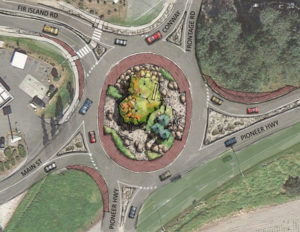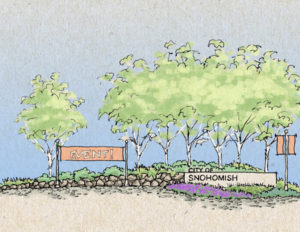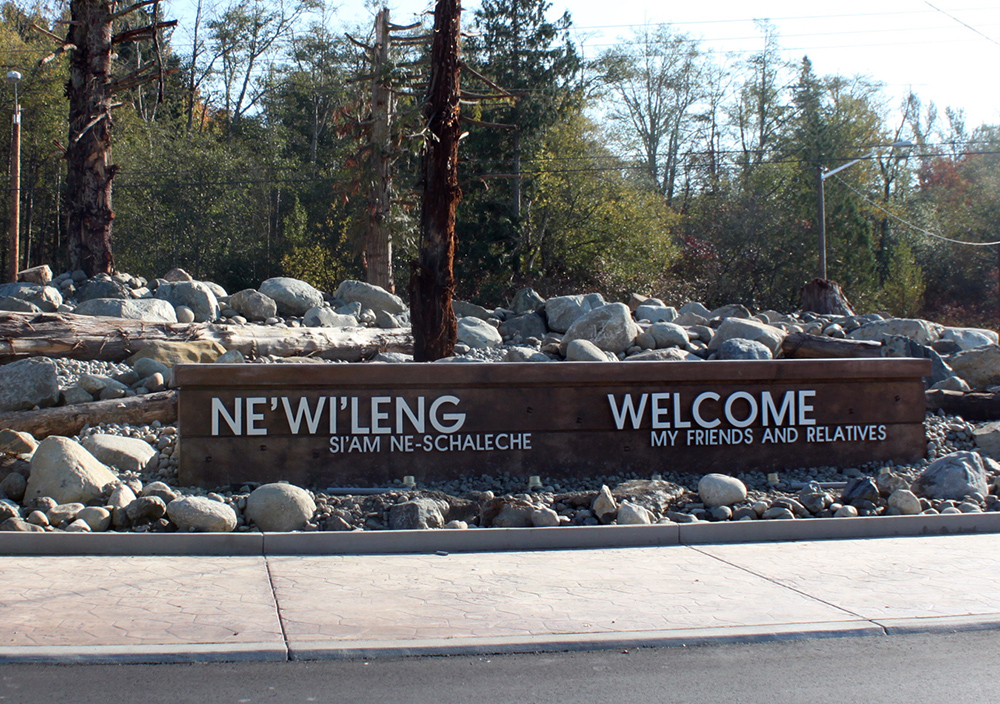The welcome sign at the Haxton & Kwina roundabout includes phrases in both English and Lummi.
As anyone who drives a car in Western Washington knows, roundabouts are becoming increasingly popular. And whether you love roundabouts or hate them is probably determined by the specific roundabouts you drive through. I have experienced a few bewildering roundabouts where two lanes abruptly become one, or a multiplicity of arrows fails to clarify the drivers’ consternation. I have also experienced roundabouts that took previously snarled and backed-up traffic and made it flow smoothly and efficiently.
As a landscape architect, I have had the opportunity to work with Reid Middleton on several roundabout design projects, including the recently constructed Haxton & Kwina
Roundabout in Whatcom County and two soon to be constructed roundabouts: Pioneer Highway and Fir Island Road Roundabout in Skagit County and 15th and Ave D Roundabout in Snohomish. I have enjoyed seeing how a landscape architect’s role in roundabout design supports the engineering of smooth, efficient roundabouts.

Civil engineers are primarily concerned with roundabout functionality: how to move the desired number of vehicles, bikes, and pedestrians through the roundabout safely. This includes a focus on slowing traffic, creating well-defined pedestrian crossings, and maintaining appropriate sight distances so that drivers can see pedestrians and other vehicles. Engineers also use the roundabout center island to create ‘target value’ for drivers approaching the intersection, alerting the driver that something is changing in the roadway ahead and deliberately obscuring the drivers’ view of the far side of the roundabout in order to keep drivers’ focus on decision-making at their point of entry.
The role of landscape architects is quite different. Roundabouts are generally located at important crossroads such as freeway off-ramps and arterial crossings, which often make them gateways to communities. The primary focus of the landscape architect is to help create a sense of place in these gateways, a space that contributes to the unique character of the community. To do this we use welcome signs, decorative plantings, decorative lighting, seasonal banners, artwork, and urban design elements, such as decorative paving and pedestrian areas with benches.

In essence, engineers use polylines, and landscape architects use splines. (Translation for those who don’t use CAD: engineers want quantifiable data; landscape architects want harmonious forms.) But rather than conflicting, the viewpoint of each discipline works to support the goals of the other. Traffic is slowed through a combination of well-designed roundabout geometry and visual cues, such as decorative plantings, decorative pavement and banners. Landscaped splitter islands provide refuge areas for pedestrians while reinforcing the character of the roundabout. And, dramatic center island landscapes with distinctive elements provide target value and obscure sightlines across the roundabout while creating community gateway features. With more jurisdictions focusing on utilizing green stormwater infrastructure to the maximum extent feasible, there is the potential to increase cross-discipline synthesis further by incorporating green stormwater infrastructure as a decorative feature of the landscape, a strategy we used successfully in the design for the 15th and Ave D Roundabout in Snohomish.
As roundabout design continues to evolve and improve, the collaboration between civil engineers and landscape architects will also evolve and improve. I am excited to see how closer collaboration will continue to create new and outstanding roundabout design solutions.



Great information and a beautiful project
As a Nashvilliian who now sees several new roundabouts in Music City, I welcome them, particularly at one Brentwood junction that was accident-ready prior to the new solution. Keep working to make these entities appropriate, tasteful, focused where they need to be, and genuinely helpful to this growing traffic-infested city!
Thank you for your comments. It’s great to get feedback on our blog posts.
Tom Tyndall – As part of our roundabout design team, I always enjoy hearing that a roundabout has improved safety at an intersection; roundabouts can be very good solutions for intersections plagued by collisions and congestion. And you’re right; we always work to ensure that a roundabout is an appropriate, tasteful solution for each unique intersection. We are glad to hear you are enjoying yours!
“Engineers also use the roundabout center island… alerting the driver that something is changing in the roadway ahead and deliberately obscuring the drivers’ view of the far side of the roundabout in order to keep drivers’ focus on decision-making at their point of entry.” This is what’s missing in the roundabouts I have experienced in the Northeast! Thank you for such a wonderful contribution to beauty and safety!
Barb Berry – Thanks! We believe the target value created by landscaping in the center island is an essential safety feature in roundabout design. We enjoy working with talented landscape architects who can translate this need for safety into something beautiful for the community to enjoy.